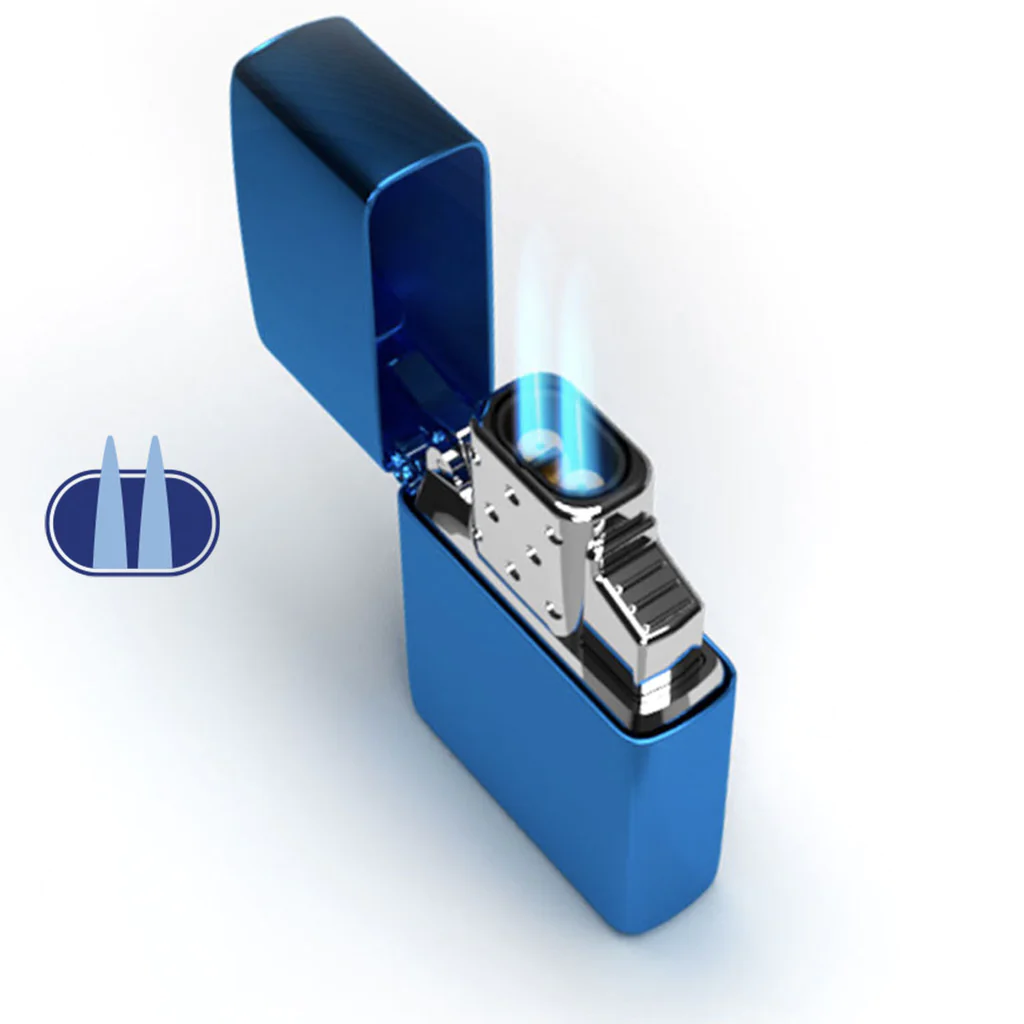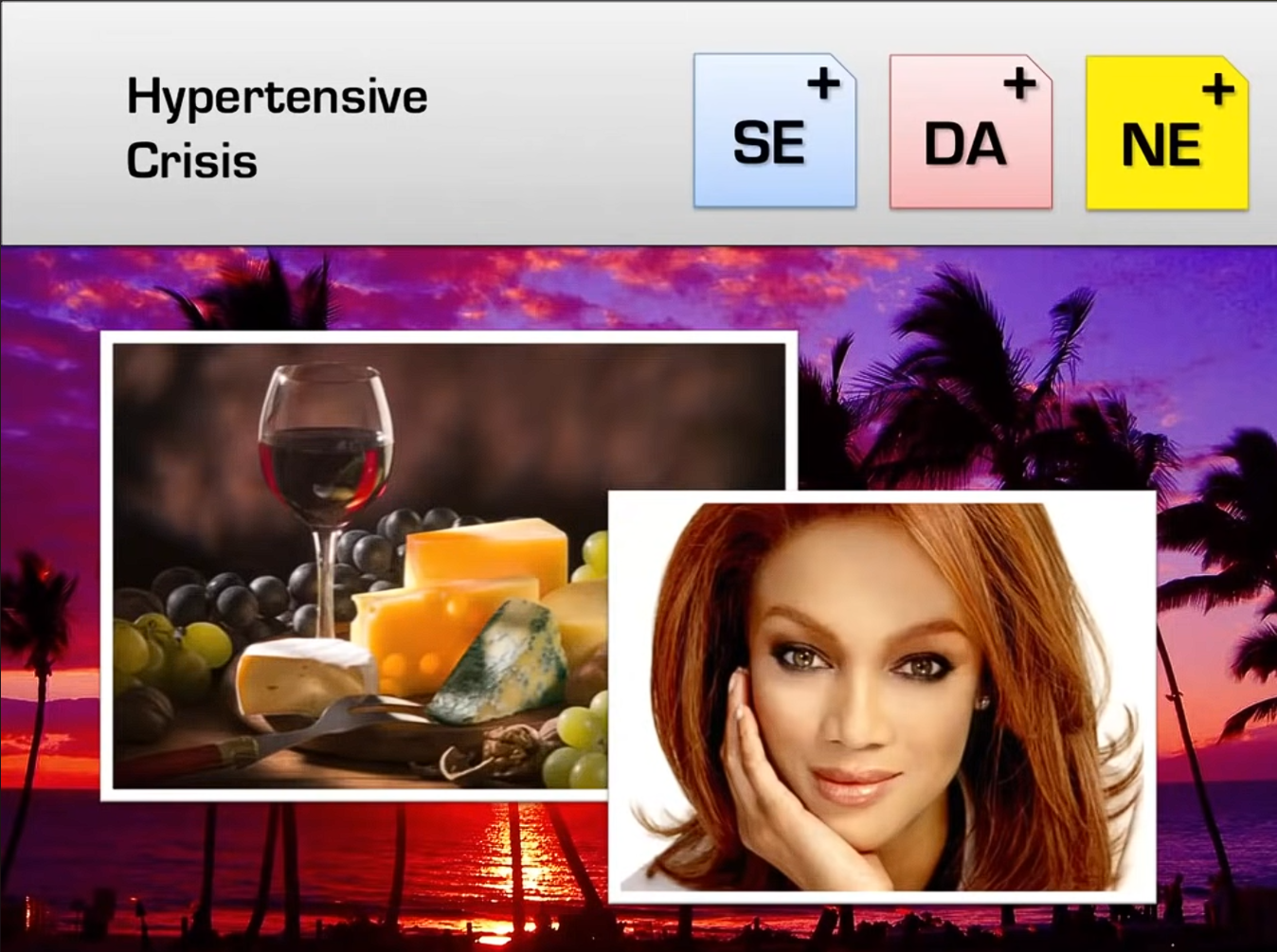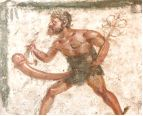| Type of Antidepressant | Neurotransmitter(s) Increased |
|---|---|
| Selective Serotonin Reuptake Inhibitors (SSRIs) | Serotonin |
| Serotonin-Norepinephrine Reuptake Inhibitors (SNRIs) | Serotonin, Norepinephrine |
| Tricyclic Antidepressants (TCAs) | Serotonin, Norepinephrine |
| Norepinephrine-Dopamine Reuptake Inhibitors (Bupropion) | Norepinephrine, Dopamine |
| Noradrenergic and Specific Serotonergic Antidepressants (Mirtazapine) | Norepinephrine, Serotonin |
| Monoamine Oxidase Inhibitors (MAOIs) | All above: Serotonin, Norepinephrine, Dopamine |
| Serotonin Antagonist and Reuptake Inhibitors (SARIs) | Serotonin |
| Serotonin Modulators and Stimulators (SMS) | Serotonin, Dopamine |
Tip
- Those who don’t increase serotonin don’t have sexual dysfunction: bupropion, mirtazapine (increase norepi to compensate)
- MAOIs increase all those neurotransmitters, thus it’s the most powerful
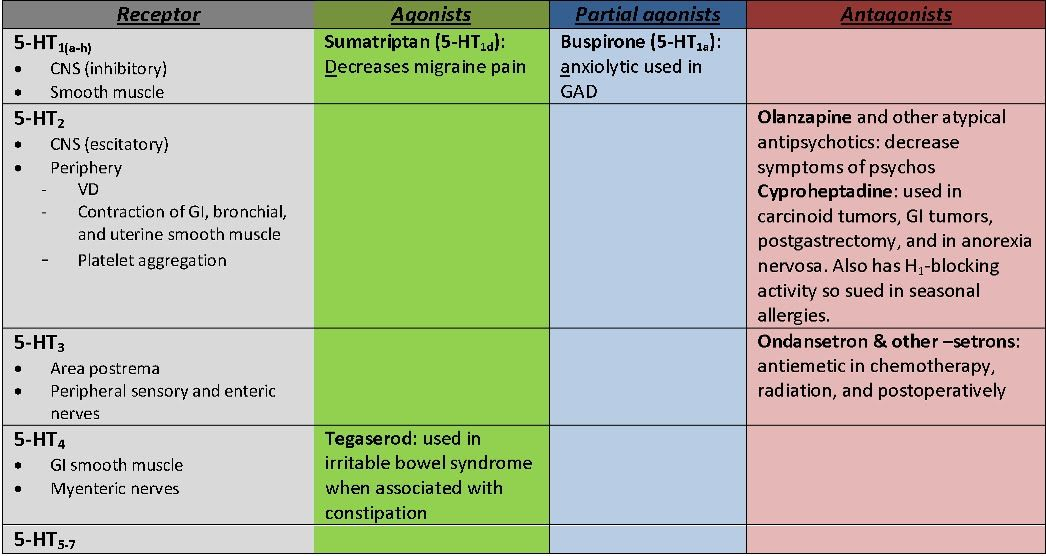
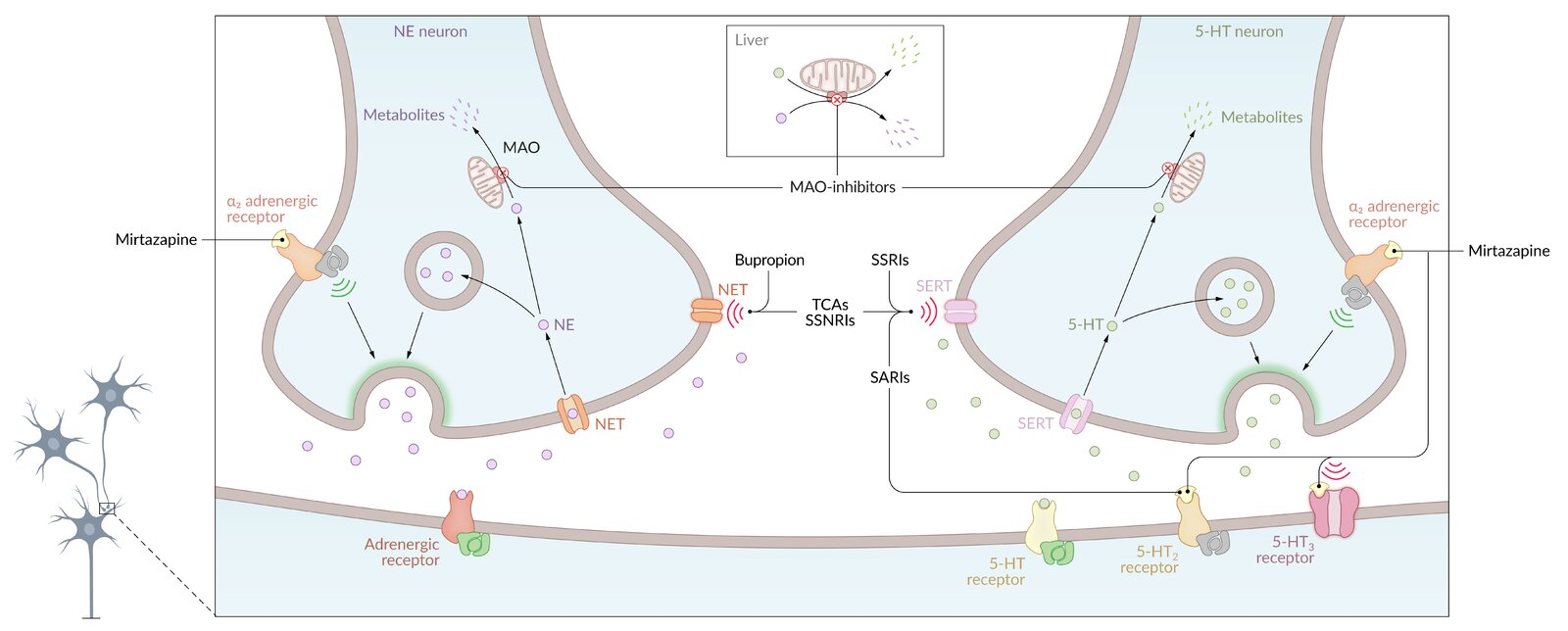
Selective serotonin reuptake inhibitors (SSRI)
Warning
Don’t use SSRI in Bipolar disorder, as it can precipitate a manic episode!
- Mechanism of action: inhibition of serotonin reuptake in synaptic cleft → ↑ serotonin levels
- Drugs
- Fluoxetine
- Paroxetine
- Sertraline
- Citalopram
- Escitalopram
- Fluvoxamine
- Indications
- Major depressive disorder (first-line therapy)
- Generalized anxiety disorder
- Obsessive-compulsive disorder
- PTSD
- Panic disorder
- Premature ejaculation
- Premenstrual dysphoric disorder
- Binge-eating disorder
- Bulimia nervosa
- Social anxiety disorder
- Side effects
- Early side effects (onset and resolution typically within 1 week of therapy start)
- Late side effects
- Sexual dysfunction (e.g., anorgasmia, ↓ libido, erectile or ejaculatory dysfunction)
- Most common, can occur in more than 50% of patients.
- SIADH
- Serotonin syndrome
- Can be caused by any drug that increases serotonin levels
- Serotonin syndrome caused by SSRIs alone typically manifests with mild symptoms (e.g., nausea, mild tremor).
- Increased risk of occurrence and greater severity of symptoms when coadministered with another serotonergic agent (e.g., MAOIs)
- Differential diagnosis: poisoning or overdose from concomitant use of substances (e.g., ethanol, salicylates) that may cause similar symptoms to serotonin syndrome (e.g., altered mental status)
- Motor disorders (e.g., tremors, bruxism)
- Sexual dysfunction (e.g., anorgasmia, ↓ libido, erectile or ejaculatory dysfunction)
Sertraline
- Ser for serotonin
- Sertraline has more GI side effects but is safe when pregnant or breastfeeding.
Mnemonic
Think squirt raline to remember diarrhea and breast milk.
Citalopram
- QT prolongation
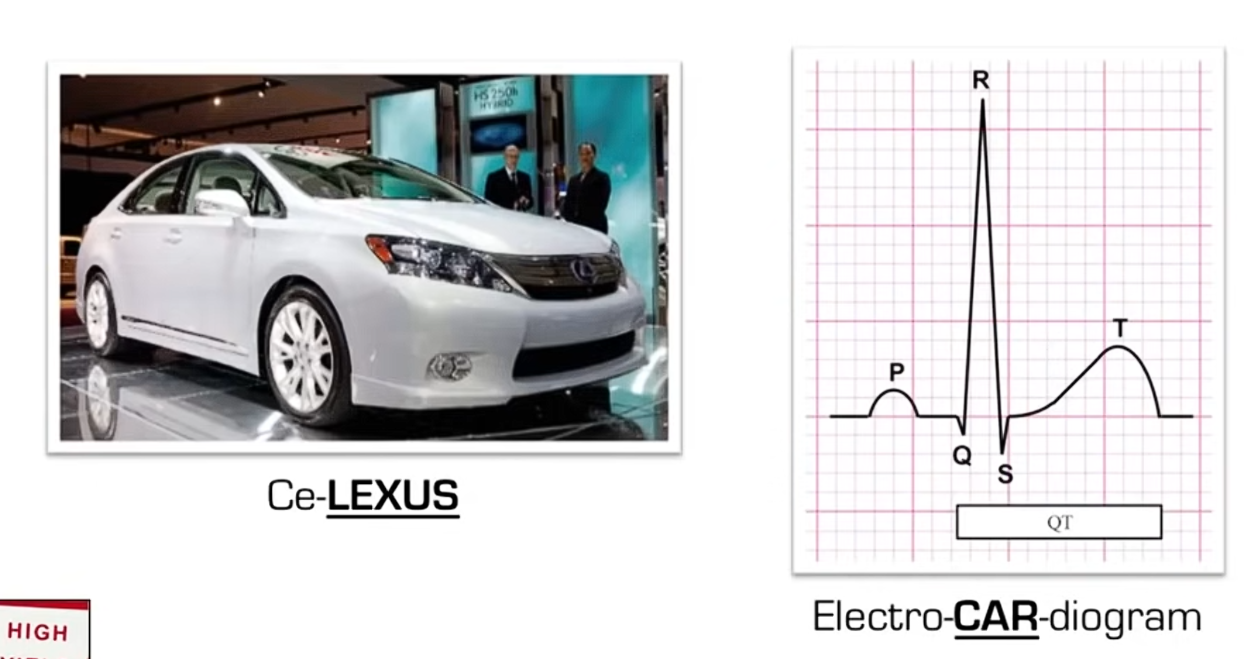
Serotonin-norepinephrine reuptake inhibitors (SNRIs)
- Mechanism of action: inhibition of serotonin and norepinephrine reuptake in synaptic cleft → ↑ serotonin and norepinephrine levels
- Drugs
- Venlafaxine
- Duloxetine
- Desvenlafaxine
- Levomilnacipran
- Milnacipran
- Indications
- Major depressive disorder (second-line therapy)
- Generalized anxiety disorder
- Neuropathic pain (e.g. diabetic neuropathy)
- Duloxetine and milnacipran specifically: fibromyalgia
- Stress incontinence in women: duloxetine
- Venlafaxine specifically: social anxiety disorder, OCD, panic disorder, and PTSD
- Side effects
- Similar profile to SSRIs
Serotonin antagonist and reuptake inhibitors (SARIs)
- Mechanism of action
- Block postsynaptic type 2 serotonin receptors (5-HT2)
- Weak inhibition of serotonin reuptake → ↑ serotonin levels
- Antagonist of H1 (histamine) and α1-adrenergic receptors
- Drugs
- Trazodone
- Indications
- Insomnia
- Major depressive disorder (high doses required)
- Side effects
- Priapism
- Blocking alpha-1 adrenergic receptors
- Sedation (due to H1 antagonism)
- Orthostatic hypotension
- Nausea
- Priapism
- Drug interactions: risk of serotonin syndrome if used concomitantly with other serotonergic drugs
- Additional information
- Mainly used as an adjunct to other antidepressants for treating insomnia associated with depression
- Two-week washout period before starting other serotonergic drugs
Mnemonic
Think “traZzzoBONE” to remember the adverse effects of sedation (Zzz…) and priapism!
Atypical antidepressants
Mirtazapine
- Mechanism of action
- Selective α2-adrenergic antagonist → ↑ serotonin and norepinephrine release
- 5-HT2 and 5-HT3 receptor antagonists → ↑ effect of serotonin on free 5-HT1 receptor is the likely cause of antidepressant action
- H1 antagonist
- Indications: major depressive disorder, especially in patients who are underweight and/or who have insomnia
- Side effects
- ↑ Appetite and weight gain: can also be a desired effect
- Sedation (due to H1 antagonism): can also be a desired effect
- ↑ Serum cholesterol and triglyceride levels
- Minimal sexual side effects
- Drug interactions: risk of serotonin syndrome if used concomitantly with other serotonergic drugs
Mnemonic
- Mirtazzzapine makes you sleepy (Zzz…).
- MEAL-tazapine
Bupropion
- Mechanism of action: increase dopamine and norepinephrine levels via reuptake inhibition
- Indications
- Smoking cessation: used in conjunction with counseling and nicotine replacement
- Major depressive disorder
- Side effects
- Stimulant effect
- Tachycardia, palpitations
- Weight loss
- Neuropsychiatric symptoms: insomnia, agitation, headache
- Reduction of seizure threshold: Bupropion should be avoided in patients at increased risk for seizure (e.g., history of epilepsy, anorexia/bulimia, alcohol or benzodiazepine withdrawal).
- Does not cause sexual side effects
- Dry mouth
- Drug interactions: risk of serotonin syndrome if used concomitantly with other serotonergic drugs
Tip
Buproprion is not associated with sexual dysfunction or weight gain. It is contraindicated in patients with seizure and eating disorders.
- Because it does not affect serotonin.
Mnemonic
Bupropion + dopamine + norepinephrine = bu-da-ne (butane).
- A butane lighter is hot, like bupropion’s lack of sexual side effects.
- A butane lighter can help you remember the association of bupropion with cigarettes.
- Bupropion should be avoided in patients with bulimia.
Buspirone
- Mechanism of action
- 5-HT1A receptor stimulation
- Requires consistent daily intake for at least two weeks because of its delayed onset of action
- Indication: anxiety disorders
- Side effects
- Headaches, dizziness
- Nausea
- Seizures resulting from chronic use
- Additional information
- Is not sedative
- No risk of addiction or tolerance
- No interaction with alcohol (as opposed to barbiturates and benzodiazepines)
Monoamine oxidase inhibitors
Most powerful among these drugs, also has worst adverse effects
- Mechanism of action
- Nonselective inhibition of monoamine oxidase → ↓ breakdown of epinephrine, norepinephrine, serotonin, and dopamine → ↑ levels of epinephrine, norepinephrine, serotonin, and dopamine
- Selegiline: selective MAO-B inhibitor → mainly ↓ breakdown of dopamine → ↑ levels of dopamine
Tip
Monoamines include dopamine, serotonin, and epinephrine.
- Drugs
- Tranylcypromine
- Phenelzine
- Selegiline
- Indications
- Major depressive disorder (third- or fourth-line therapy): particularly effective treatment for atypical depression
- MDD with atypical features is characterized by mood reactivity (ie, mood improves in response to positive events), leaden paralysis (ie, patient’s arms and legs feel extremely heavy), rejection sensitivity (ie, overly sensitive to slight criticism), and the reversed vegetative signs of increased sleep and appetite.
- Parkinson disease: selegiline (as an adjunct to carbidopa-levodopa)
- Major depressive disorder (third- or fourth-line therapy): particularly effective treatment for atypical depression
- Side effects
- CNS stimulation
- Sexual dysfunction, can cause priapism
- Orthostatic hypotension
- Weight gain
- Hypertensive crisis with ingestion of foods containing tyramine
- Examples: aged cheeses, smoked/cured meats, alcoholic beverages (especially beer and red wine), dried fruits, fava beans, chocolate
- Tyramine is an indirect sympathomimetic found in certain foods (eg, aged cheeses, cured meats, draft beer) that is usually broken down in the gastrointestinal tract by MAO. In MAO inhibitor–treated patients, tyramine escapes degradation and enters the systemic circulation, leading to a hypertensive crisis.
- Tyramine stimulates the sympathetic nervous system by releasing other neurotransmitters, such as noradrenaline, from vesicles into the synaptic cleft.
Mnemonic
- Picture being on a date with Tyra Banks over wines and cheeses at a resort in Maui (an island in Hawaii). (This will be nervous and your blood pressure sky high)
- Think of trazodone as trazo bone to remember priapism
- Additional information
- Before starting new serotonergic drugs or ceasing dietary restrictions (e.g., foods containing tyramine), MAOI therapy has to be stopped for at least 2 weeks.
- To wait for MAO is resynthesized to a level adequate for normal monoamine degradation
- Before starting new serotonergic drugs or ceasing dietary restrictions (e.g., foods containing tyramine), MAOI therapy has to be stopped for at least 2 weeks.
Tricyclic antidepressants (TCA)
- Mechanism of action: inhibition of serotonin and norepinephrine reuptake in synaptic cleft → ↑ serotonin and norepinephrine levels
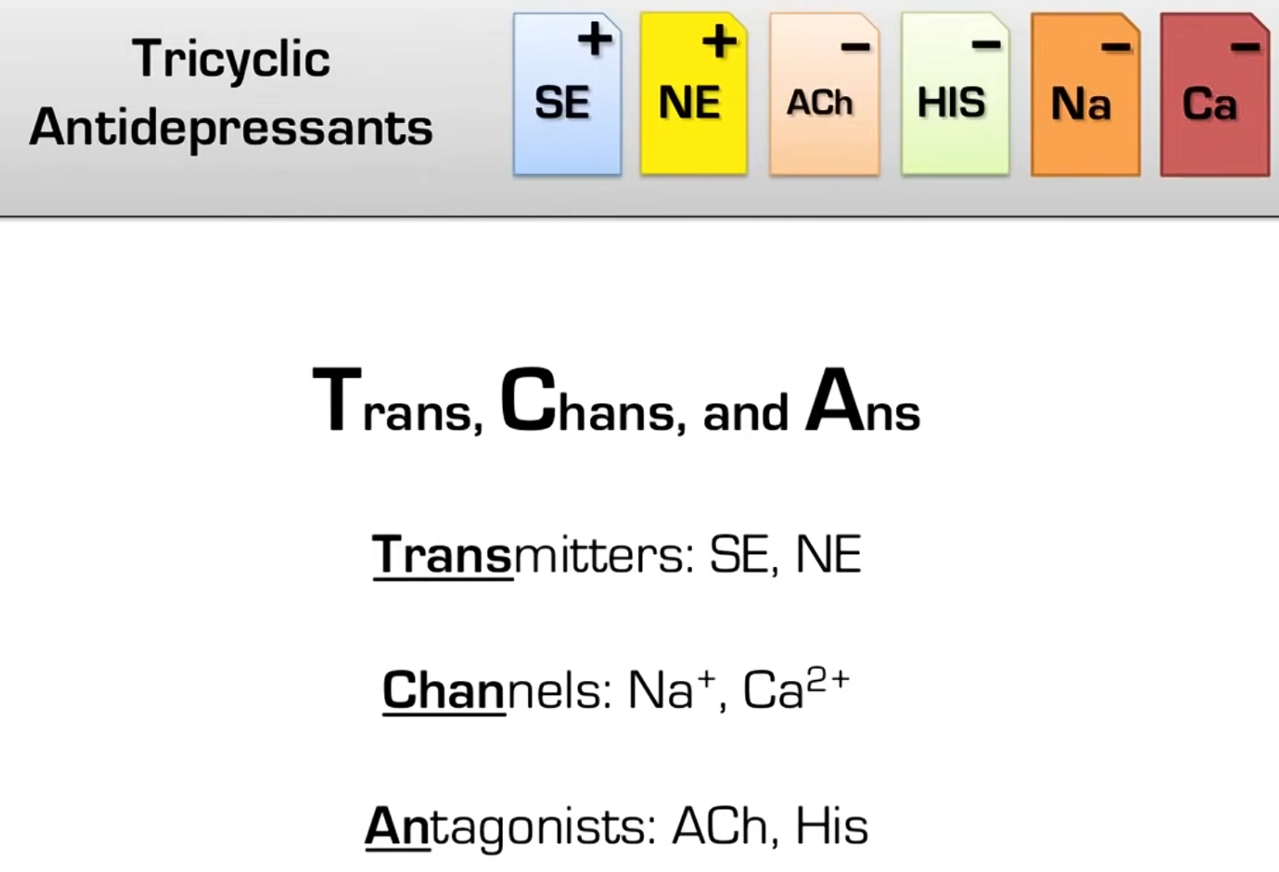
- Drugs
- Secondary amines
- Nortriptyline
- Desipramine
- Protriptyline
- Amoxapine
- Tertiary amines
- Amitriptyline
- Clomipramine
- Doxepin
- Imipramine
- Trimipramine
- Secondary amines
- Indications
- Major depressive disorder (third- or fourth-line therapy)
- Neuropathic pain (e.g., peripheral neuropathy, diabetic neuropathy, postherpetic neuralgia)
- Chronic pain (including fibromyalgia)
- Migraine prophylaxis
- Clomipramine specifically: OCD
- Imipramine specifically: nocturnal enuresis (limited use due to side effects)
- Side effects
- Orthostatic hypotension
- Cardiotoxicity due to Na+ channel inhibition in the myocardium: changes in cardiac conductivity velocity, arrhythmias, prolonged QT interval (predisposes to torsades de pointes), wide QRS complex
- Treatment is sodium bicarbonate
- Tremor
- Anticholinergic symptoms due to blockage of muscarinic cholinergic receptors (more common with tertiary amines)
- TCAs have structural similarities to acetylcholine, enabling them to bind to and block muscarinic receptors.
- Cardiovascular: tachycardia, arrhythmia (including ventricular fibrillation), hypotension
- CNS: confusion, hallucinations, sedation, seizures (confusion and hallucinations are most commonly seen in older patients)
- Gastrointestinal: constipation
- Genitourinary: urinary retention
- Imipramine = I’m peeing-ramine
- General: xerostomia
Mnemonic
A sodium bi car bonate can run over a tricycle
